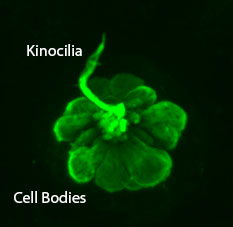Research
Hair cells are specialized sensory cells important for hearing and balance in mammals. Hair cell death and dysfunction are major causes of human hearing loss. Hair cells are sensitive to a number of insults including loud noises, aging, certain therapeutic medications such as aminoglycoside antibiotics and chemotherapeutics, and environmental toxins such as heavy metals. My research uses zebrafish to uncover the cellular processes involved in hair cell development and death. By conducting a forward genetic screen, I discovered that genes regulating cilia function play important roles in hair cells. Cilia are microtubule-based projections on cells that are involved in multiple cell signaling processes. Early in their development, all hair cells contain a single primary cilium called the kinocilium. One of the main goals of my research moving forward is to gain further insight into the roles cilia genes play in hair cell function and dysfunction and to gain new insight into cilia biology. I am also interested in further understanding how other toxins lead to hair cell death and have recently started investigating heavy metal-induced hair cell death.
The Zebrafish Lateral Line
Hair cells of the zebrafish lateral line are morphologically and functionally similar to the sensory hair cells of the mammalian inner ear. They are also sensitive to the same therapeutic medications that kill mammalian hair cells. The surface location of zebrafish lateral line hair cells makes them easy to manipulate and visualize in vivo. You can see a 5-day old transgenic zebrafish larva below expressing green fluorescent protein (GFP) specifically in hair cells. These hair cells cluster together in structures called neuromasts. This collection of neuromasts along the length of the fish’s body makes up the lateral line system.

Lateral line hair cells have very long kinocilia making them a great system to study the localization and trafficking of cilia-localized genes. You can see this in the magnified view of a single neuromast below.

You can find further information about my two primary research interests at the links below:
Additionally a full list of my publications and external grants can be found at the following link.